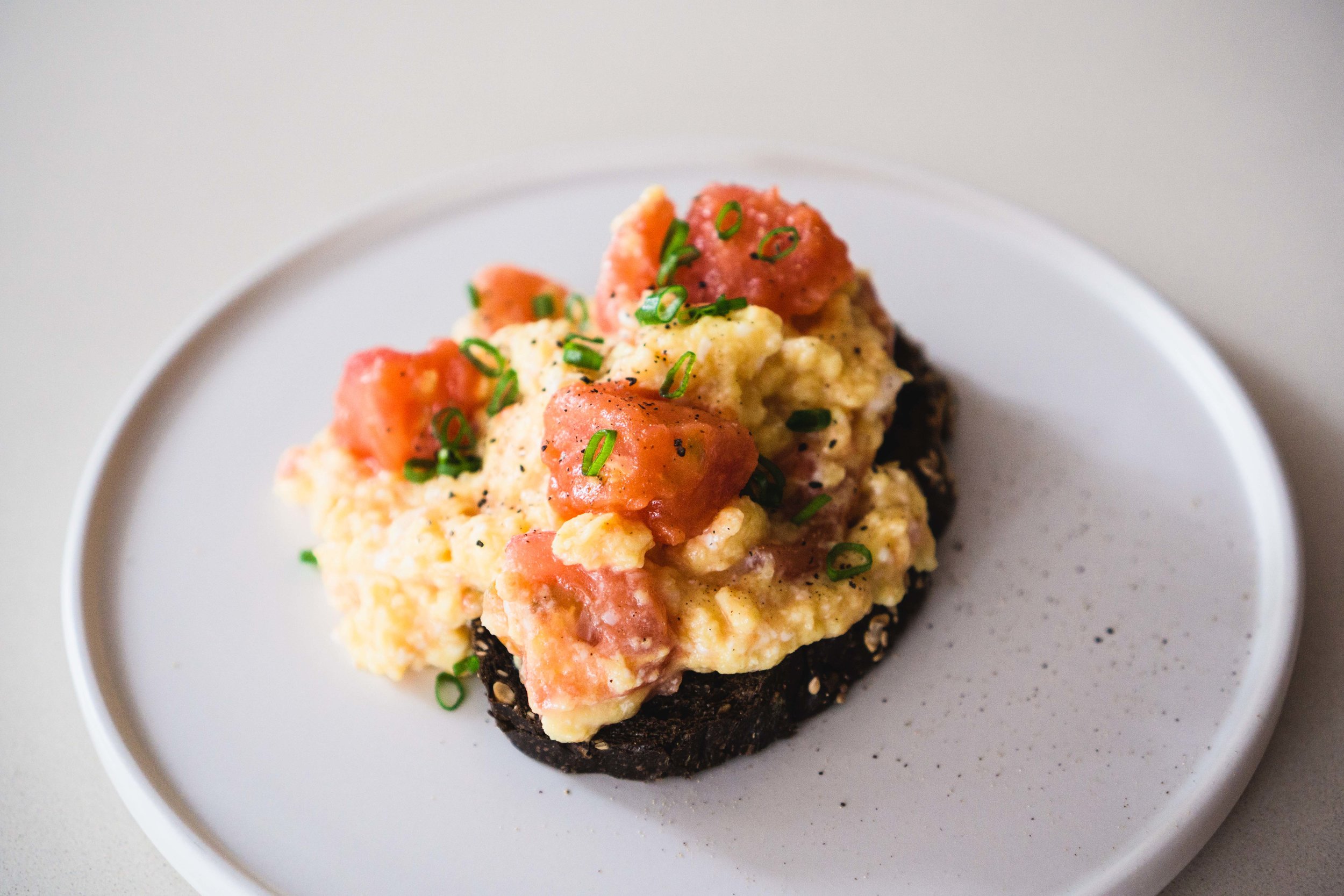Boujee Tomato Eggs (番茄炒蛋)
I first developed this recipe for Food52. And though tomato eggs is undoubtedly a classic Chinese dish, this boujee version is so kooky, so unnecessarily renegade, so much in the spirit of this blog, that I couldn’t not share it here. So, boujee-fy away!
For many second- or third-generation Chinese immigrants, myself included, fān qíe chǎo dàn (or stir-fried tomatoes and eggs) is the third dish we learn to cook from our parents. First and second would probably be instant noodles and perfect rice-cooker rice (with a rice-to-water ratio measured with fingers, not with cups).
In other words, you don’t need much cooking experience to make tomato eggs; in fact, it comes together in less than 15 minutes, even if you’re a kitchen novice. At its core, it’s just tomatoes and eggs scrambled together in a pan, finished off with some Shaoxing wine and sesame oil to give it that Canto-Chinese aroma.
But strip away the convenience factor and the wistful cultural ties, and the average tomato eggs—especially those hastily made ones at home when you’re bogged down with work and only have a couple minutes to whip up dinner—let's be real, aren't that exciting. Maybe it’s just the chef in me wanting to bring out the best in every dish, because despite being satiated and comforted each time I eat a 10-minute tomato eggs, I know that the combination of creamy, buttery eggs, and tangy sweet tomatoes can, and should, amount to so much more.
So here are a few extra things I do to ensure that my tomatoes and eggs are their best selves.
The Tomatoes
Let me just start this subsection by saying I loathe the tomatoes in most tomato eggs. They’re often soggy and leaky, with their clear juices oozing out onto the eggs, diluting the rich creaminess of the eggs. The solution? Cook them longer!
Instead of lightly sautéing them before adding the eggs, I took half of the tomatoes and cooked them past the point of mush, concentrating their flavor into a thick, jammy puree. Only then do I toss in the other half of the tomatoes and cook them through, shorter this time, so they retain their shape but are coated in the sweet puree of the first round of concentrated tomatoes.
One more thing: This might be a personal preference, but it’s worth de-skinning your tomatoes, too, before cooking them. Just blanch them in hot water and shock them in an ice bath, and the skins should peel off easily. It makes for smoother, more uniform tomatoes that don’t leave bits of fiber stuck in between your teeth. In other words, a more pleasurable eating experience.
The Eggs
In the typical, hastily put-together tomato eggs, the eggs will go one of two ways: either rubbery and overcooked, or worse, gloopy and wet. But it doesn’t have to be this way.
My gold standard when it comes to scrambled eggs is Gordon Ramsay’s version. It’s lusciously creamy and barely set. The French might’ve been the ones to invent it, but Ramsay was the one who successfully proselytized this slow-scrambling method. In his now famous video with 16 million views, Ramsay starts off with the eggs in a cold pan. He then cooks it over a medium flame, and with a spatula, stirs it so furiously yet with such focus, in the way only Ramsay can. And as the eggs coagulate and come together, he takes it on and off the heat, controlling the texture of his eggs, "treating it like a risotto." This makes for the best scrambled eggs, in my opinion.
The only way in which I strayed away from Ramsay’s recipe is toward the end: Instead of the dollop of crème fraiche that Ramsay adds to enrich and temper the scrambled eggs, I added in a dash of Shaoxing wine and sesame oil to give it that iconic flavor base.
So, with an extra five minutes of careful cooking, you can avoid the usual pitfalls of tomato eggs, and end up with a creamy, tangy, and unexpectedly rich dish. I mean, with near-confited tomatoes and Gordo’s scrambled eggs, this is one elevated version of 番茄炒蛋 that I can absolutely get behind.
P.S. Sacrilegious as it may be, this version goes great on toast, too, versus the usual white rice. (But you didn’t hear it from me.)
Boujee Tomato Eggs
Serves 2-4
Ingredients
6 tomatoes
1 tbsp oil
¼ tsp kosher salt
6 eggs
1 tbsp butter
1 tsp Shaoxing wine, or rice wine
1 tsp sesame oil
1 scallion, thinly sliced, to garnish
Two slices of sourdough, for serving
Directions
De-skin the tomatoes: Ready a pot of boiling water and an ice bath. With a paring knife, lightly score the bottom of each tomato with a cross. Drop the tomatoes in the boiling water and cook 10 to 15 seconds. Remove them from the water and immediately plunge into the ice bath. Peel the skins off of the tomatoes; they should come off really easily. Then, slice each tomato into 8 wedges.
Cook the tomatoes: In a pot or a small pan, heat the tablespoon oil over medium heat. Add about half of the tomatoes, season with a pinch of salt, and cook 6 to 8 minutes, until the tomatoes are really soft and have turned into a thick puree. Add the rest of the tomatoes, cook 3 minutes longer, then set aside. (This second round of tomatoes should still retain their shape.)
Scramble the eggs: Crack your eggs into a cold saucepan and add the knob of butter. Place over medium-low heat. As the eggs cook, stir continuously with a spatula, scraping the bottom bits off the pan to prevent large chunks from forming. We want velvety smooth scrambled eggs here. It takes a while to come together, but you should get just barely set scrambled eggs within 4 to 5 minutes of stirring and cooking. If you find that your eggs are scrambling too quickly, take your pan off the heat for a few seconds, stirring vigorously, before putting it back on the heat to continue cooking. When the eggs are sufficiently scrambled (they should be viscous but still very slightly runny), add the Shaoxing wine, sesame oil, and the rest of the salt, and give it all a quick stir.
Add the tomatoes to the scrambled eggs, and give one or two final stirs. (We don’t want the tomatoes to stain and blend into the eggs too much; you could even reserve some of the tomatoes to place on top of the eggs.)
Garnish with scallions and serve. (Tomatoes and eggs are best had with white rice, but I like it on top of toasts for Chinese-inspired tartines.)



